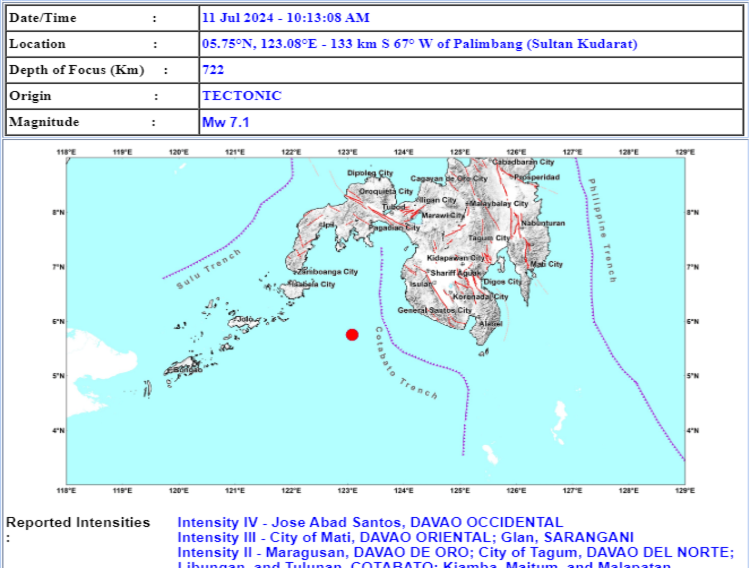On Thursday, July 11, 2024, at precisely 10:13 a.m., a powerful earthquake struck Palimbang, Sultan Kudarat, registering a magnitude of 7.1. from 6.5 as reported earlier. The Philippine Institute of Volcanology and Seismology (PHIVOLCS) confirmed the details of the seismic event, noting its tectonic origin.

Details of the Earthquake
Date/Time: July 11, 2024 – 10:13:08 AM
Location: Latitude: 05.75°N Longitude: 123.08°E 133 km S 67° W of Palimbang, Sultan Kudarat
Depth of Focus: 722 km
Origin: Tectonic
Magnitude: Mw 7.1
Tectonic Origin and Depth
The earthquake’s tectonic origin indicates that it was caused by the movement of the Earth’s tectonic plates. With a depth of 722 kilometers, this was classified as a deep-focus earthquake. Such deep earthquakes typically cause less surface shaking compared to shallower quakes, but they can still be felt over a larger area.
Aftershocks Anticipated
PHIVOLCS has warned that aftershocks are expected following the main earthquake. Aftershocks are smaller tremors that occur in the same general area during the days to years following a larger event. These can pose additional hazards, particularly to structures already weakened by the initial quake.
Impact on the Region
While the full extent of the damage and potential casualties is still being assessed, residents of Palimbang and surrounding areas are advised to stay vigilant. The depth of the earthquake suggests that the immediate surface shaking might not have been as intense as that from a shallower quake of the same magnitude. However, given the strength of the tremor, precautionary measures and preparedness are crucial.
Historical Context
The Philippines is located along the Pacific Ring of Fire, an area known for its high seismic activity due to the movement of several tectonic plates. This makes the country particularly prone to earthquakes and volcanic eruptions. The region of Sultan Kudarat has experienced significant seismic activity in the past, although the depth of this particular quake is notable.
Preparedness and Response
Local authorities, emergency services, and disaster response teams have been mobilized to assess the situation and provide necessary aid. Residents are urged to follow the guidance of local officials and PHIVOLCS, including staying away from damaged structures, preparing for aftershocks, and ensuring that emergency supplies are readily available.
PHIVOLCS’ Role
PHIVOLCS continues to monitor the situation closely and will provide updates as more information becomes available. The agency plays a critical role in earthquake preparedness and response in the Philippines, offering vital information and recommendations to ensure public safety.
The magnitude 7.1 earthquake that struck near Palimbang, Sultan Kudarat, serves as a reminder of the seismic risks faced by the Philippines. As aftershocks continue to pose a threat, vigilance and preparedness are key to minimizing the impact of such natural disasters on communities. Residents are encouraged to stay informed through official channels and to take proactive steps to ensure their safety.
